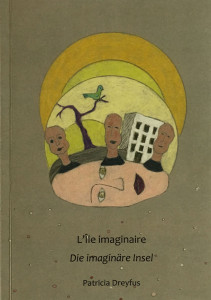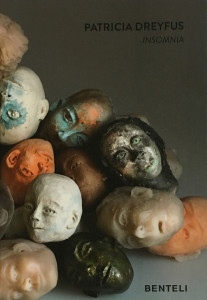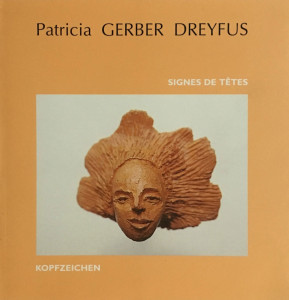About heads, bodies and other relations
Harald Theiss
About heads, bodies and other relations
Text Harald Theiss I Translation Matthew Partridge
Modelled heads, over and again: floor installations, behind glass, in groups or individually mounted on metal rods. At eye level, with their presence they acquire minimal physical traits and intimacy. In clay or bronze, Patricia Dreyfus’s heads betoken an inner gaze, prompting viewers to adopt a form of introspection that is not infrequently unsettling. The innumerable and occasionally isolated heads in her installation Charbon (Coal), or in the work Le sable (The sand), offer up a plethora of possible readings, leaving one with an unsettling sense of ambivalence. Even those colourful heads in heaps, as in Insomnia, remind us of mass graves or even shrunken heads. On closer and more focused inspection Patricia Dreyfus’s heads mutate into strange protagonists of a seemingly vanished world. But Dreyfus is less interested in relics and history than she is in stories. All her partially coloured clay or bronze heads have personal traits. At first sight they remind us of the familiar miniatures displayed in the glass cabinets of ethnological museums which often conform to idealised images. By contrast, the expressions of the human Têtes, as Patricia Dreyfus calls them, have much more individuality. They resemble portraits of people she might have run into by accident. Yet in their broad diversity they develop their own – self-constructed –mythology.
The heads seek dialogue without creating distance, in spite of, or precisely because of their fragile appearance. Encountering them is more of a confrontation than in Dreyfus’s recent drawings where her heads give way to entire bodies. As they rise up from the ground, the long black rods are transformed into lines that converge to create scenarios not unlike those of her installations. Her characteristic, mostly female figures are drawn, animated and, more recently, embroidered. In the textile works they sometimes disappear into the folds thrown by the fabrics, or they suddenly reveal themselves again, appearing to rise up out of the surfaces. They first emerge as fragments of bodies gradually unveiling themselves the moment we unfurl the embroidered fabric, similar to her animated works where we become accomplices to her unfolding stories. Dreyfus invites viewers to participate in the creative process, during which the lines converge or, indeed, draw apart again.
Previously, the artist had already depicted her female figures in a radical manner in numerous drawings. In this way she also offers us a glimpse inside her head. Myriad drawings have come about, most of them over the last twenty years – all done quite automatically, to use the artist’s words. Initially, they were no more than isolated sketches; then came her Carnets (Notebooks) in which with the help of lines she recorded her serial obsession on paper, page by page, in an increasingly narrational way. The Carnets are more than mere sketchbooks; they constitute a distinct body of work within her oeuvre. Automatistically, or by their own accord, because the artist does not consciously model her work on source material. The drawings are comparable to the Surrealists’ “écriture automatique”. André Breton described this process as creative production without being censored or steered by thinking. Ideally, it takes place in an intermediate state of half-sleep in twilight.
In her pictorial quest, so the artist tells us, the unpredictable plays a crucial role. It shapes her entire work, thrives on this state of insomnia and finds expression without subjection to censorship. In Surrealism, too, the unconscious and dreams were used as sources of creativity. Dreyfus’s fanciful depictions peopled with mythical figures, human beings and animals are mysterious and charged with symbols. Trees, houses, cages, birds and snakes are reminiscent of dream sequences whose stories could conceivably be autobiographically fuelled. Viewers are challenged to pursue their own associations. Thus, the drawings serve as avenues for reflection and can be read in a variety of ways. Here lies one of the many fortes of Patricia Dreyfus’s body of drawings whose narrative is conjugated in often complex and unsettling images, offering glimpses of unfathomable depths. The question is then: consciously or not? Her dream images move us and allow us to participate in states of mind that evoke both shameless candour and fragility, and thereby prompt a variety of different responses. The symbolic elements are condensed into enigmatic settings suggestive of interior worlds marked by their own psycholinguistic imagery. These are (imagined) pictorial realities haunted by memories, personal history and physical and mental experiences.
Memories mark and shape identities. Particularly when it comes to female artists of our time, their artistic work often reflects their personal experience and suffering. Similarly, in Patricia Dreyfus’s works we also encounter references to her personal past and history, interpretable maybe as reconstructions. Her work is closely tied to her own personal life and can be read as a kind of complex intimate diary. In the drawing La femme aux nouvelles (The woman with the news), we see a female figure covering her nudity with a book. Likewise, in Lettre à moi-même (Letter to myself) the writing emerging from her inner depths is simultaneously delivered into the outside world.
Dreyfus’s drawings are highly physical, very corporeal. For the artist, the act of drawing is a never-ending productive process by which the imagined is transformed in its entirety into subjective images in which a coherent visual language and narrative are fused. As mentioned before, at the forefront of this narrative is the autobiographical context and the unconscious need to seek a system of order. Nonetheless, a number of elements remain alien and elude any possibility of interpretation. Rather, these are signs permeated by corporeality that leave clues in the present. Dreyfus’s dogged perseverance with her drawing is unique, just like the state of uncertainty in her scenarios with their constantly varying density, representing a human condition that is fragile and bereft of orientation, akin to her animation pieces where they appear even more to be part of an imagined reality.
More recently, this abstract mood has gained even greater intensity in her embroideries, a relatively fresh medium in Dreyfus’s work. To those familiar with her drawings it makes sense to view this kind of traditional craft – which also used to be called silk shading and even today is still considered more a female pursuit – as a logical consequence of her artistic practice. Stitching as rebellion. Her embroideries do not involve patterns or ornaments, although sometimes they employ inscriptions, albeit with a different, more personal tendency. I will survive can be read on one of her latest pieces, almost like a news ticker. Dreyfus is not interested in precision or attention to detail, preferring instead to leave quasi-fractured lines on the fabric. As in her drawings, figuration and abstraction are woven into stories.
Cloth is generally an intimate and supple material, suitable for shrouding or cloaking, capable of becoming a second, protecting skin, unlike other materials used by Patricia Dreyfus. The thread brings the inner skin out into the open, what was previously concealed is made visible.
The pieces of cotton cloth offer the artist an almost perfect surface, and not only as a way of further exploring her artistic craft. As a work process, stitching is quite a different physical experience, and potentially more painful too. In these works taking the form of sketches we can also detect autobiographical references. She repeatedly addresses the issue of female identity, of disturbed sexual relations. Sexuality and the evidently associated role of the mother are fundamental motifs in all of Patricia Dreyfus’s most recent works – as woman, artist and mother. Similar to Louise Bourgeois’ Umbilical Cord (2002), the capacity to give life and the intrinsically related corporeal bond to other human beings throughout life are at the same time also an expression of unrelenting vulnerability.
Patricia Dreyfus’s multi-faceted artistic work, in which the principle of repetition constitutes the unifying element between her sculptures, animation pieces, embroideries and drawings, is an almost obsessive and unsparing confrontation with her own life. Her life is the source of her artistic imagination from which she draws stimulation to reflect the ubiquitous and universal conditions of human – and specifically female – experience and understanding.
Berlin, March 2019 I Harald Theiss, art historian, curator and author
* André Breton, « Die Manifeste des Surrealismus », Deutsch von Ruth Henry, Reinbek bei Hamburg, 1968, S. 11-29.
Köpfen, Körpern und anderen Verwandtschaften
Harald Theiss
Modellierte Köpfe, immer wieder: Bodeninstallationen mit unzählig vielen Köpfen, Köpfe hinter Glas arrangiert, wieder andere Köpfe gruppiert und auf einzelne Metallstäbe fixiert - nahezu in Augenhöhe platziert, entwickeln sie mit ihrer Präsenz minimale Körperlichkeiten und Nähe. Mit ihren Köpfen aus Ton oder Bronze schaut Patricia Dreyfus in Köpfe hinein. Damit provoziert sie bei den Betrachterinnen und Betrachtern einen selbstreflektierenden Blick, der nicht selten auch verstörend sein kann. Vor allem die schwarzen Felder in der Arbeit Charbon, mit den unzähligen Köpfen, nur manchmal vereinzelt und im Sandboden fast verloren, hinterlassen in ihrer Mehrdeutigkeit ein unbequem ambivalentes Stimmungsbild. Selbst die farbigen und aufgehäuften Köpfe, wie bei Insomnia, erinnern uns an Massengräber oder auch an Schrumpfköpfe. Bei näherer und einzelner Betrachtung werden Patricia Dreyfus’ Köpfe zu seltsam anmutenden Protagonisten einer scheinbar vergangenen Zeit. Dreyfus ist aber nicht an Relikten und Geschichte interessiert, sondern vielmehr an Geschichten. Ihre zum Teil farbigen Köpfe aus Ton oder Bronze haben alle individuelle Züge. Nur zu Beginn erinnern sie an die uns vertrauten und in Glasvitrinen ausgestellten Miniaturen in den Museen der Kulturen, die in ihrer Ausführung oft einem idealen Bild entsprechen. Viel individueller dagegen sind die Gesichtsausdrücke bei den menschlichen «Têtes», wie Patricia Dreyfus sie nennt. Sie erscheinen wie Portraits von Menschen, denen sie irgendwo und irgendwann begegnet ist. Und dennoch, in ihrer Vielzahl entwickeln sie eine eigenständige, von ihr konstruierte Mythologie.
Die Köpfe fordern auf eine distanzlose Art zum Dialog auf, trotz oder gerade wegen ihrer fragilen Erscheinung. Die Begegnung mit ihnen ist konfrontativer als in Dreyfus‘ späteren Zeichnungen, in denen die Köpfe zu vollständigen Körpern ausgeführt werden. Sie erheben sich vom Boden und die langen schwarzen Stäbe formen sich zu Linien, die sich wie schon in den Installationen zu Szenerien verdichten. Ihre unverkennbaren, meist weiblichen Figuren werden gezeichnet, animiert und jüngst auch gestickt. In den textilen Arbeiten verschwinden sie manchmal in den Faltungen, welche die Stoffe werfen. Oder sie machen sich plötzlich wieder mehr sichtbar - scheinen aus den Flächen hervorzutreten. Es sind zunächst Fragmente und Spuren von Körpern, die sich uns möglicherweise erst beim Aufschlagen der bestickten Stoffe gänzlich „entblößen“ - ähnlich wie in den animierten Arbeiten, bei denen wir zu Komplizen ihrer erzählten Geschichten werden. Dreyfus läßt die Betrachter teilnehmen am Entstehungsprozess, bei dem sich die Linien erst im Laufe einer abgespielten Zeit verbinden oder auch wieder auflösen.
Davor hat die Künstlerin ihre Frauenfiguren bereits in vielen Zeichnungen auf eine radikale Art dargestellt. Auf diese Weise erlaubt sie uns auch in ihren Kopf zu blicken. Die unzähligen Blätter sind zumeist in den letzten 20 Jahren und, wie Dreyfus selber sagt, automatisch entstanden. Erst waren es einzelne Skizzen und dann die Carnets, in denen ihre serielle Obsession mit Linien, vor allem übers Blättern, erzählerischer auf Papier festgehalten wird. Die Carnets sind mehr als nur Skizzenbücher - sie bilden innerhalb des gesamten Werkes von Dreyfus eine eigene künstlerische Position. Automatisch oder wie von selbst deswegen, weil Dreyfus nicht nach Vorlagen arbeitet, sind sie vergleichbar mit der surrealistischen „écriture automatique“. André Breton hat die "écriture automatique" als einen Vorgang beschrieben, bei dem das Schreiben dem Denken unzensiert und unkontrolliert folgt. Am besten gelingt dies in einem Zwischenzustand des Halbschlafes in der Dämmerung.
"Wer sich nicht selbst auf diesem Weg versucht hat, wird alle Mühe haben, sich ihn genauer vorstellen zu können."(André Breton) *
In der Bildfindung spielt nach eigener Aussage der Künstlerin das Unvorhersehbare eine entscheidende Rolle. Es prägt ihr gesamtes Werk und speist sich aus diesem Zustand von Insomnia und kommt in gewisser Weise unzensiert zum Ausdruck. Auch im Surrealismus wurde das Unterbewusste und der Traum als kreative Quelle genutzt. Dreyfus imaginäre Darstellungen mit Fabelwesen, Menschen, Tieren sind rätselhaft und symbolisch aufgeladen: Bäume, Häuser, Käfige,Vögel und Schlangen erinnern an Traumsequenzen, deren Geschichten, es lässt sich vermuten, autobiografisch geprägt sind. Die Betrachter werden, in ihren Vorstellungen, aufgefordert, sie weiter zu denken. Die Blätter wirken daher manchmal wie Denkaufgaben und sind vielschichtig lesbar. Hier liegt eine der vielen Stärken in Patricia Dreyfus zeichnerischem Oeuvre, das oft in komplexen und verstörend wirkenden Bildern erzählt und nicht selten in Abgründe blickt - es stellt sich die Frage: bewusst oder unbewusst? Ihre Traumbilder berühren und lassen uns an Zuständen teilhaben, die von schamloser Offenheit und gleichzeitig von Zerbrechlichkeit erzählen und somit unterschiedliche Reaktionen auslösen. Die symbolischen Elemente verdichten die rätselhaften Szenarien, die wie Bilderwelten aus dem Inneren wirken - geprägt von einer psycholinguistischen Bildersprache. Es sind (imaginäre) Bilderwirklichkeiten, besessen von Erinnerungen, Erfahrungen, Erlebnissen und Erkenntnissen.
Erinnerungen prägen und formen Identitäten. Gerade bei Künstlerinnen unserer Zeit reflektiert das Werk oft das eigene Erlebte und Erlittene. So finden sich auch in den Arbeiten von Patricia Dreyfus Bezüge zur persönlichen Vergangenheit und Geschichte, und sie können als deren Rekonstruktionen interpretiert werden. Das Werk ist eng vom Leben der Künstlerin geprägt und kann als eine Art komplexes Tagebuch gelesen werden. Neben dem Motiv der Bibel ist auch ein Buch in der Zeichnung «La femme aux nouvelles» zu sehen, in der sich die weibliche Figur damit bedeckt, ebenso in «Lettre à moi- même», in dem das aus dem tiefsten inneren Geschriebene gleichzeitig nach Außen gelassen wird.
Dreyfus’ Zeichnungen sind sehr körperlich. Für die Künstlerin ist der Akt des Zeichnens ein nie endender Produktionsprozess, bei dem das Imaginäre als Ganzes in subjektive Bilder transformiert wird und die eine kohärente visuelle Sprache und Narration vereinen. Im Zentrum dieses Narrativs steht, wie gesagt, ein autobiografischer Zusammenhang und eine unbewusste Notwendigkeit, nach einem Ordnungssystem zu suchen. Dabei bleibt vieles auch fremd und entzieht sich so einer Deutungsmöglichkeit. Es sind vielmehr (Körper) Zeichen, die in der Gegenwart Hinweise hinterlassen. Die Zeichen sind durchdrungen von Körperlichkeit. Dreyfus zeichnerische Eigensinnigkeit ist unverkennbar, ebenso der immer wieder unterschiedlich dichte Schwebezustand der Szenerien, in denen eher ein menschlicher Zustand von fragiler Orientierungslosigkeit dargestellt ist und für die Betrachterinnen und Betrachter zum Ereignis wird - ähnlich wie bei den Animationen, in denen sie noch stärker Teil einer imaginären Wirklichkeit werden.
Ein abstrahiertes Stimmungsbild ist jüngst auch verstärkt in den Stickereien zu beobachten, einem Medium, mit dem Dreyfus noch nicht lange arbeitet. Kennt man ihre Zeichnungen liegt es nahe, dass ihr das traditionelle Handwerk, früher auch Nadelmalerei genannt und bis heute einer eher weiblichen Tätigkeit zugerechnet, als eine Konsequenz ihrer künstlerischen Praxis zu betrachten ist. Sticken als Rebellion. Ihre Stickereien zeigen keine Muster oder Ornamente; Schriftzüge schon, nur mit einem anderen, vor allem persönlichen Anspruch - I will survive ist auf einer ihrer letzten Arbeiten und fast wie eine Nachricht zu lesen. Dreyfus interessiert sich nicht für die Präzision und Liebe zum Detail, sondern hinterlässt auf dem Stoff eher brüchige Linien. Wie in den Zeichnungen werden Figuration und Abstraktionen zu Geschichten vernäht.
Das textile Material ist an sich ein intimer und weicher Stoff, der das Verhüllen erlaubt und zu einer zweiten und schützenden Haut werden kann. Anders mit und in den Werkstoffen bei Dreyfus. Die innere Haut wird mit dem Faden spürbar nach Außen getragen, das Verborgenen sichtbar gemacht.
Die Baumwolltücher bieten der Künstlerin eine beinahe perfekte Oberfläche, nicht nur um ihr künstlerisches Handwerk weiterzuentwickeln. Das Sticken ist im Entstehungsprozess eine andere körperliche, möglicherweise auch schmerzhaftere Erfahrung. Autobiographische Bezüge finden sich auch in diesen, in der Ausführung skizzenhaften Arbeiten. Dabei kommt ihr Fadenstrich auf vielfache Weise zum Einsatz. Immer wieder thematisiert sie weibliche Identitäten, durcheinander geratene Geschlechterverhältnisse. Sexualität und die damit auf natürliche Weise verknüpfte Mutterrolle bleiben auch in den jüngsten Arbeiten von Patricia Dreyfus - als Frau, Künstlerin und Mutter - wiederkehrende Motive. Ähnlich wie bei Louis Bourgois in Umbilical Cord (2002) ist die Fähigkeit, Leben zu geben, und die damit unabdingbare starke körperliche Verbindung zu Menschen ein Leben lang gleichzeitig auch ein Ausdruck von ständiger Verletzbarkeit.
Patricia Dreyfus vielfältige künstlerische Arbeit, in der das Prinzip der Wiederholung das verbindende Element in ihren Skulpturen, Animationen, Stickereien und Zeichnungen ist, bleibt eine beinahe obsessive und schonungslose Auseinandersetzung mit dem eigenen Leben. Es bildet die Motivation ihres künstlerischen Schaffens und dennoch reflektiert sie damit allgegenwärtige und allgemein gültige Zustände menschlicher – und spezifisch weiblicher - Erfahrung und Erkenntnisse.
Berlin, März 2019 I Harald Theiss, Kunsthistoriker, Kurator und Autor
* André Breton, « Die Manifeste des Surrealismus », Deutsch von Ruth Henry, Reinbek bei Hamburg, 1968, S. 11-29.


